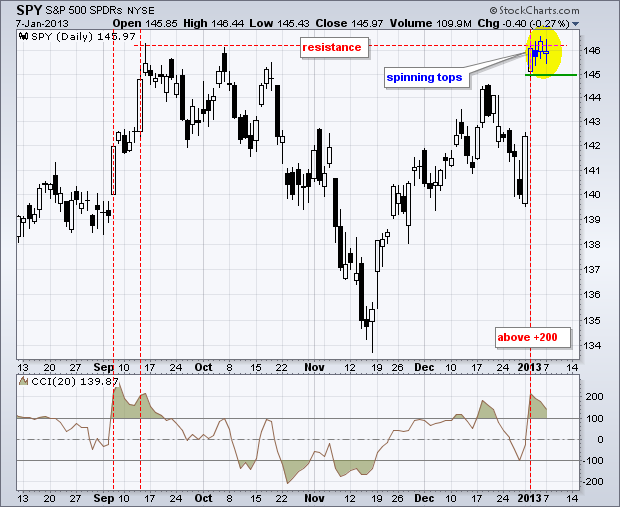Trading was rather quiet as the world returned to work on Monday. The S&P 500 ETF (SPY) formed its third spinning top candlestick in as many days. Spinning tops feature small bodies (open-close range) and relatively equal upper-lower shadows (high-low range). They indicate indecision that can sometimes foreshadow a short-term reversal. It is important, however, that chartists consider the spinning top in context. Note that these spinning tops formed at resistance and SPY became short-term overbought last week. In addition to a 6+ point surge, the Commodity Channel Index (CCI) moved above +200. There is overbought (above +100) and then there is OVERBOUGHT (above +200). Frankly, I pretty much ignore overbought readings above +100 because they are too frequent. The combination of indecision, resistance and overbought conditions makes SPY ripe for a pullback. Careful though. Note how SPY continued higher after the early September surge and did not peak until the second overbought reading.





**************************************************************************

**************************************************************************

**************************************************************************

**************************************************************************

**************************************************************************
Key Reports and Events:
Wed - Jan 09 - 07:00 - MBA Mortgage Index
Wed - Jan 09 - 10:30 – Oil Inventories
Thu - Jan 10 - 08:30 - Jobless Claims
Thu - Jan 10 - 10:30 - Natural Gas Inventories
Charts of Interest: Tuesday and Thursday
This commentary and charts-of-interest are designed to stimulate thinking. This analysis is
not a recommendation to buy, sell, hold or sell short any security (stock ETF or otherwise).
We all need to think for ourselves when it comes to trading our own accounts. First, it is
the only way to really learn. Second, we are the only ones responsible for our decisions.
Think of these charts as food for further analysis. Before making a trade, it is important
to have a plan. Plan the trade and trade the plan. Among other things, this includes setting
a trigger level, a target area and a stop-loss level. It is also important to plan for three
possible price movements: advance, decline or sideways. Have a plan for all three scenarios
BEFORE making the trade. Consider possible holding times. And finally, look at overall market
conditions and sector/industry performance.

About the author:
Arthur Hill, CMT, is the Chief Technical Strategist at TrendInvestorPro.com. Focusing predominantly on US equities and ETFs, his systematic approach of identifying trend, finding signals within the trend, and setting key price levels has made him an esteemed market technician. Arthur has written articles for numerous financial publications including Barrons and Stocks & Commodities Magazine. In addition to his Chartered Market Technician (CMT) designation, he holds an MBA from the Cass Business School at City University in London.
Learn More